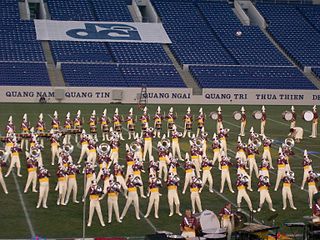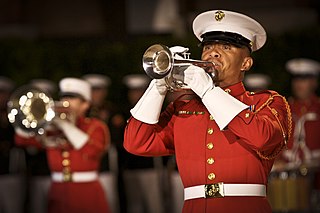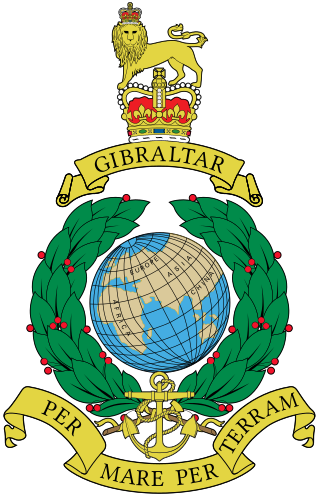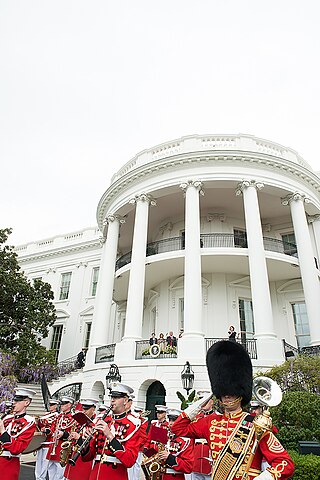A corps is a large military unit usually composed of two or more divisions.
Contents
Corps may also refer to:
A corps is a large military unit usually composed of two or more divisions.
Corps may also refer to:

A modern drum and bugle corps is a musical marching unit consisting of brass instruments, percussion instruments, electronic instruments, and color guard. Typically operating as independent non-profit organizations, corps perform in competitions, parades, festivals, and other civic functions. Participants of all ages are represented within the corps activity, but the majority are between the ages of 13 and 22 and are members of corps within Drum Corps International or Drum Corps Associates.

Corps (or Korps; "das ~" (n), German pronunciation: [ˈkoːɐ] (sg.), (pl.)) are the oldest still-existing kind of Studentenverbindung, Germany's traditional university corporations; their roots date back to the 15th century. The oldest corps still existing today was founded in 1789. Its members are referred to as corps students (Corpsstudenten). The corps belong to the tradition of student fraternities which wear couleur and practice academic fencing.

A military band is a group of personnel that performs musical duties for military functions, usually for the armed forces. A typical military band consists mostly of wind and percussion instruments. The conductor of a band commonly bears the title of Bandmaster or Music director. Ottoman military bands are thought to be the oldest variety of military marching bands in the world, dating from the 13th century.

Classic drum and bugle corps are musical ensembles that descended from military bugle and drum units returning from World War I and succeeding wars. Traditionally, drum and bugle corps served as signaling units as early as before the American Civil War, with these signaling units having descended in some fashion from ancient drum and fife corps. With the advent of the radio, bugle signaling units became obsolete and surplus equipment was sold to veteran organizations. These organizations formed drum and bugle corps of civilians and veterans, and the corps performed in community events and local celebrations. Over time, rivalries between corps emerged and the competitive drum and bugle corps circuit evolved.
Drum and bugle corps is a name used to describe several related musical ensembles.

United States military bands include musical ensembles maintained by the United States Army, United States Marine Corps, United States Navy, United States Air Force, and United States Coast Guard. More broadly, they can also include musical ensembles of other federal and state uniformed services, including the Public Health Service and NOAA Corps, the state defense forces, and the senior military colleges.

The United States Marine Drum & Bugle Corps is the drum and bugle corps of the United States Marine Corps. The D&B is now the only full-time active duty drum corps in the United States Armed Forces. As one of many United States military bands, the United States Marine Drum & Bugle Corps consists of 80 active-duty Marines dressed in ceremonial red and white uniforms. The D&B performs martial and popular music.

The Royal Marines Band Service is the musical wing of the Royal Navy and an independent element of the Royal Marines. It currently consists of five bands plus a training wing – the Royal Marines School of Music at HMS Nelson – and its headquarters is at HMS Excellent, Whale Island, Portsmouth.

A Corps of Drums, sometimes known as a Fife and Drum Corps, Fifes and Drums or simply Drums is an army unit used in several nations. Drummers were originally established in European armies to act as signallers. The major historical distinction between a military band and a corps of drums is that 'drummers' were not employed to play their instruments to entertain or delight, but instead to carry out a utilitarian battlefield role. This role is fulfilled by trumpeters or buglers in the cavalry and the artillery, who traditionally did not form into organised groups in the way that drummers did; therefore, a typical corps of drums would exist in the infantry arm.

Corps Rhenania Heidelberg is a member Corps of the Kösener Senioren-Convents-Verband, the oldest association of student fraternities in Germany, Austria and Switzerland. Corps Rhenania is "pflichtschlagend", which refers to the fact that it requires of its members, that they participate in several ritual, organised duels with members of other specific student fraternities. Eligible applicants are those students, both current and former, of the Ruprecht Karl University in Heidelberg, Germany. Members of Corps Rhenania are colloquially referred to as "Rhenane".
Cesar Yatco Alzona Laguna, Philippines, was the author of the original first Philippine Marines Hymn. He also authored another Marine-themed song, entitled "First to Fight." He served valiantly and received much praise as a military leader in the Marine Corps of the Philippine Navy against Muslim terrorists and Islamic insurgents in the southern island of Mindanao during the early years of Philippine independence from the United States in the 1950s. He was also one of the Filipino military personnel of the Korean war.

A fanfare band, fanfare corps, fanfare battery, fanfare team, horn and drum corps, bugle band, drum and bugle corps, or trumpet and drum band is a military or civilian musical ensemble composed of percussion instruments, bugles, natural horns and natural trumpets. Fanfare bands are the descendants of the old medieval trumpet and drum teams that sounded fanfares on important occasions and are related to drum and bugle corps internationally.

Canadian military bands are a group of personnel in the Canadian Armed Forces (CAF) that performs musical duties for military functions. Military bands form a part of the Music Branch of the CAF, composed of six full-time professional Regular Force bands, 15 Regular Force voluntary bands, and 53 part-time reserve force bands. Bands of the Music Branch are often badged with the unit or Canadian Forces base insignia that they support.

United States military music customs are the traditional, regulatory, and statutory provisions that guide performances by United States military bands during drill and ceremony and state occasions.

The United States Air Force Academy Drum and Bugle Corps also known as the Flight of Sound is the drum and bugle corps of the United States Air Force Academy and a military band in the United States Armed Forces. Unlike United States Air Force Academy Band, the drum and bugle corps is staffed by USAFA cadets from the Cadet Wing. 80 cadets make up the band, with 60% of the members being from the freshman class. The two bands perform in different uniforms, with the former wearing the full dress uniform of the United States Air Force while the latter wears the standard cadet uniform. Compared to the United States Marine Drum and Bugle Corps, it is not a full time band.

The Music of the Foreign Legion, formerly known as the Principal Music of the Foreign Legion is a Military band of the French Foreign Legion.

A mounted band is a military or civilian musical ensemble composed of musician playing their instruments while being mounted on an animal. The instrumentation of these bands are limited, with the musician having to play their instrument, as well as steer the animal to the designated location. Most mounted bands, therefore, use instruments that can easily be held, such as bugles, horns, and Fanfare trumpets. Timpani and glockenspiels are also a common feature, usually located at the head of a band. Although a band that is mounted on any member of the families Equidae and Camelidae are considered to be a mounted band, horses are most commonly used, mostly being employed in military bands in Europe, North and South America, and some parts of Asia.

The Philippine Marine Corps Drum and Bugle Team (MDBT) is the drum and bugle corps as well as the prime musical unit of the Philippine Marine Corps. The MDBT is now the only full-time active duty drum corps in the Armed Forces of the Philippines (AFP). This unit emulates the United States Marine Drum and Bugle Corps of the United States Marine Corps. The MDBT is led by an NCO Drum Major during parades.

The Marine Corps Musician Enlistment Option Program (MEOP) is the central organized body overseeing the active-duty military bands of the United States Marine Corps. Marine Corps field bands can be found in the Southeast United States, Southern California, and the Pacific-Asia region. While serving with their bands, Marines perform throughout the continental United States and travel internationally to locations ranging from Beijing to Paris. These units take part in activities such as retirement ceremonies, the Marine Corps Birthday Ball, funerals, change of commands, and civil/military parades. It is one of two music programs in the Department of the Navy, with the other being Fleet Band Activities.

The military bands of the United Kingdom are musical units that serve for protocol and ceremonial duties as part of the British Armed Forces. They have been the basis and inspiration for many military bands in the former British Empire and the larger Commonwealth of Nations as well as musical organizations in other countries. Military musical units with British influence include United States military bands, the Japan Ground Self-Defense Force Music Corps and the Military Band of Athens. British military bands are controlled by the military music departments of the three services that compose the armed forces. These include the Royal Marines Band Service, the Royal Corps of Army Music, and the Royal Air Force Music Services. British style brass bands and carnival bands were then and are currently inspired by the British Armed Forces and its brass bands, especially of the Army's regular and reserve formations, as they follow a similar format as it relates to brass and percussion instruments.